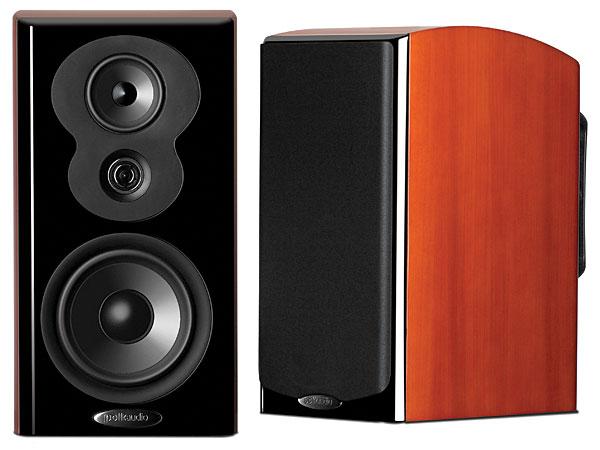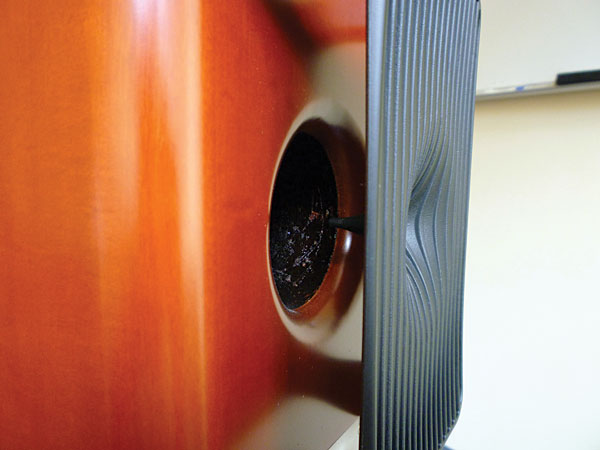| Columns Retired Columns & Blogs |
Polk LSiM703 loudspeaker

When a reviewer specializes in seeking out innovation and value in affordable loudspeakers, certain manufacturers warrant revisiting again and again—companies that consistently deliver high-value products, but also steadily revamp their lines to trickle down design innovations to ever more affordable models.
Polk Audio is such a company. During my years at Stereophile I've covered their RT25i (September 2001), which I bought and still own; the LSi7 (March 2003); and the RTiA1 (September 2008). Each model, when reviewed, exemplified great value and competed well with all other designs at or near its price. As it's now exactly four years since I last covered a Polk speaker, I felt it was time to revisit the company to see and hear what they've been up to.
Although Polk now designs (in the US) and manufactures (in China) more than 20 two-channel speakers, their most expensive model, the floorstanding LSiM707, still costs only $3999.90/pair—nowadays, that can be less than the price a pair of interconnects. Whereas in the past I concentrated on the more affordable Polk designs, for this review I wanted to hear how their most expensive bookshelf, the LSiM703 ($1499.90/pair), a direct descendant of the flagship LSiM707, would fare in my listening room.
Design
The rear-ported, three-way LSiM703 incorporates what Polk calls a Dynamic Sonic Engine: its midrange driver and ring-radiator tweeter are housed in an "enclosure-within-the-enclosure." The 3.25" midrange driver is mounted above the tweeter in an enclosure that's molded as a single unit. The 1" tweeter has its own tuned enclosure within the Engine. The cones of both the midrange unit and the 6.5" woofer are made of mineral-filled polypropylene, into which air has been injected to form a honeycomb structure. This is intended to provide a combination of light weight, stiffness, and high damping. The speaker's crossovers include Mylar and polypropylene capacitors, air-core inductors, and notch filters and Zobel circuits to smooth the impedance curve and provide greater efficiency and extended high-frequency response.
The gorgeous cabinets of the review samples were finished in Mount Vernon Cherry (Midnight Mahogany is also available). Under the veneer are panels of MDF 1" thick on the sides, ¾" thick on the back and bottom, and, on the front, a baffle 1¼" thick. The LSiM703 has an innovative, zero-diffraction grille that locks in place magnetically. I slightly preferred the sound of the Polks with their grilles off: there was a negligible increase in detail resolution and transparency, but no change in timbre. But grilles off or on, I found the LSiM703's appearance sexy.
Listening
For my auditioning, I biwired the Polks—they can also be biamped—and placed the speakers on my trusty Celestion Si stands, loaded with sand and lead shot.
The LSiM703's detailed, uncolored midrange made it a natural match for well-recorded pianos and voices. Pianist Anat Fort's subtle jazz textures in her A Long Story (CD, ECM 1994) were warm, liquid, and involving, with a sense of a real instrument playing in my listening room. Joni Mitchell's voice in "Sex Kills," from her Turbulent Indigo (CD, Reprise 45786-2), was bathed in a round, silky, golden glow; and further down the audioband, Paul Simon's naturally chesty lower register shone through on his So Beautiful or So What (CD, Hear Music 32814-02). The Polk's ability to unravel detail let me precisely follow every nuance of the hand drums layered under Simon's voice.
In fact, the LSiM703's resolution of detail let me hear "new" events in recordings I'd played dozens of times before. I'm a huge fan of the opening movement of David Chesky's Violin Concerto, performed by soloist Tom Chiu accompanied by Anthony Aibel conducting Area 31 (SACD/CD, Chesky SACD288, CD layer)—but with the Polk, for the first time I was able to follow the individual flute lines buried deep in the orchestration of the first movement, and found it very easy to hear individual pitches in the timpani melody in the opening statement. Listening to Orphée, from John Zorn's Mysterium (CD, Tzadik 8018), I had no problem following the low-level dynamic envelope of marimbist David Shively's every mallet stroke.
In honor of the death of actor George Lindsey, who played Goober Pyle on The Andy Griffith Show from 1964 to 1968, I dug out his 96 Miles to Bakersfield (LP, Capitol ST-230), the sequel to Goober Sings. I was a fan of the show in my childhood, but that's not why I chose this record. It holds the unique honor of being the musically worst of my 12,000 LPs. Stereophile's founder, J. Gordon Holt, once posited that a recording's sound quality tends to be inversely proportional to its musical merit. In full accordance with Holt's Law, the elaborate but cheesy arrangements of these throwaway pop tunes are spectacularly recorded. In "Everything Else Is Just Toothpaste," it was very easy to pick out every nuance of the bluegrass Coral electric sitar line (yes, you read that right) against the in-your-face honky-tonk piano.
The LSiM703's extended, detailed, uncolored high frequencies enabled it to render violinist Tom Chiu's opening solo in the Chesky concerto with a full complement of airy, extended harmonics, and with every nuance of his bowing revealed. Similarly, my favorite solo album by Derek Bailey, Improvisation (CD, Ampersand 2), was rendered with every subtle pluck and pling of this unorthodox guitarist's unique dynamic envelope intact and enveloped in a long, shimmering decay. However, the one aspect of the Polk that concerned me was the tendency for the highs in densely modulated passages to call attention to themselves. In the fortissimo passages of Zorn's Orphée, when Shively and electronic percussionist Ikue Mori get very active, the highs were a bit forward in a way that they weren't in the piece's quieter passages. And in the Joni Mitchell track, when the synthesizers and Mitchell's flattop guitar crescendo together in the choruses, the result was a bit jangly. Finally, in the more frenetic passages of the Sultans of String's Move (CD, Outside Music MCK 2050), the interplay of the plucked and bowed instruments was a bit cacophonous. I should point out, however, that in 90% of my listening to the LSiM703, the highs did not call attention to themselves and the speakers did not sound bright.
The Polk's ability to articulate transients made me want to listen to percussion recordings. Frank Zappa and Ruth Underwood's percussion duet in his "Re-Gyptian Strut," from LÑther (CD, Rykodisc RCD 10574/76), is a bit of a blitz, but every little wrinkle emerged naturally from the LSiM703s with no trace of smear or loss of definition. I also found myself studying Ringo Starr's snare and tom-tom technique in the George Harrison masterpiece "It's All Too Much," from Yellow Submarine Songtrack (CD, Apple CDP 5 21481 2).
I'm anxious to read John Atkinson's measurements of the Polk LSiM703, as I was quite taken with the clarity, extension, and high-level dynamic authority of its bass. The knuckle-rap test indicated an enclosure fairly free of resonances for a speaker of its size and price. My acid test for bass definition is the Spaceship section of Philip Glass's Einstein on the Beach (CD, Nonesuch 79323-2). Through the LSiM703, the undulating, rapid-fire bass-synth passages were clean and crisp, with nary a trace of overhang, smear, or smudge, each note as delicate, uncolored, and forceful as the one before.
At both ends of the dynamic spectrum with every recording I tried, the Polk seemed to breathe in a linear, organic fashion, as if I were listening to live music. Listening to "Re-Gyptian Strut," I wanted to jump up and conduct the band, as Zappa did on his US tours. "Drama!" say my listening notes. In Peter Zummo's Zummo with an X (CD, New World 80656-2), every subtle nuance of the dynamic envelope of Bill Ruyle's tabla emerged intact. Finally, Saudades, the live recording by Jack DeJohnette's Trio Beyond (2 CDs, ECM 1972), with guitarist John Scofield and organist Larry Goldings, felt like a live recording in a club through the Polks, which evenly and linearly reproduced entire dynamic range from ppp to fff.

What I liked best about the LSiM703 was its ability to reproduce coherent musical pictures from small-group jazz recordings. Liam Sillery's climactic trumpet solos in the title track of his Phenomenology (CD, OA2 Records 22061) were naturally layered over Thomas Morgan's double bass in a tightly focused package. And the churning percussion of brothers Robert and E.J. Rodriguez on Marc Ribot y los Cubanos Postizos (CD, Atlantic 83116-2) rolled and chugged along like broad-hipped dancers, anchored by Brad Jones's rumbling, linear bass.
Beauty Contest
I compared the Polk LSiM703 ($1499.90/pair) to the Dynaudio Excite X12 ($1200/pair), Epos M16i ($1995/pair), and Monitor RX6 Silver ($1250/pair). The Dynaudio is a bookshelf; the Epos and Monitor Audio floorstanders.
The Dynaudio Excite X12 revealed more inner detail and longer decays in the midrange than the Polk, with more linear microdynamics and highs that were more silky and delicate. However, the Dynaudio's bass was a bit warmer and not as deep as the Polk's, and its high-level dynamics were a bit inferior.
The Epos M16i's midbass was as clean as the Polk's, though the LSiM703 went lower. The Epos better rendered midrange detail, and its high-level dynamic capabilities were as impressive as the Polk's. High frequencies were a touch more detailed through the Epos, though neither it nor the Polk was as silky on top as the Dynaudio Excite X12.
The Monitor RX6 Silver's midrange detail also bettered the Polk's, and its microdynamics were very revealing and linear. The Monitor also had the most forceful and extended bass of all of four speakers, as well as the best high-level dynamics and great transients. Its highs weren't as delicate as the Dynaudio's, but were a touch purer than the Polk's.
Resolution
In the LSiM703, Polk Audio has created a revealing, neutral, dynamic, and cosmetically stunning, three-way bookshelf loudspeaker, and has once again demonstrated its ability to offer excellent value for money. There is stiff competition at or near its price of $1499.90/pair, and some of those other speakers exceed its performance in one or two areas, but the LSiM703 holds its own overall. Once again, my hat is off to the Polk design team. I look forward to their future affordable speaker models.
- Log in or register to post comments




































